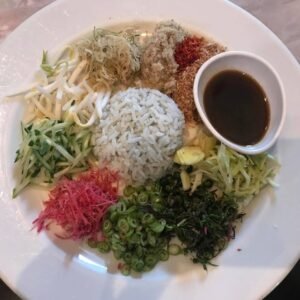
Nasi Kerabu or Khao Yam – An Iconic Dish for Thai Muslim Communities
Almost everyone is familiar with the dish Nasi Kerabu or Khao Yam, in the three southernmost provinces of Thailand with a majority Muslim Population. It is a local dish, which has become famous throughout the country. It is also interesting to see the dish having a presence in the food culture of other Southeast Asia countries although it may have a different flavour, depending on the region; Muslim Thai people in the three southern border provinces, Malay people in Peninsula as well as to the island of Sumatra and Java of Indonesia have this dish in common.
It is also referred to differently according to each locality where Malay is an Austronesian language, officially spoken in Brunei, Indonesia, Malaysia, Singapore, and unofficially spoken in East Timor and in southern parts of Thailand. In Thailand, Nasi Kerabu is referred to as Khao Yam in Thai, but it’s normally called Nasi Kerabu in the three southernmost border provinces and some parts of Malaysia that border with Thailand. In some parts of Malaysia and Indonesia versions of it are also called Nasi Ulam.
There is no clear origin of Khao Yam or Nasi Kerabu, but there are several stories that have been told for centuries regarding this dish; Nasi kerabu was made during the month of fasting in the kingdom of Phraya Nakhon when many people had abdominal pain. Some had diarrhea and some flatulence. The doctor of the royal palace was ordered to solve this problem. Later, the doctor suggested that everyone opens their fast at the same time and eat the recipe that he invented, which was, Nasi Kerabu.
Khao Yam’s main ingredient is rice, which comes in two colours: black and yellow. Black colour comes from Morinda juice cooked with rice and has antioxidant properties. The yellow rice contains turmeric, which helps cure flatulence and heal wounds in the intestines.
The dish can also be traced to Malaysia, as a dish of Kelantanese origin. This dish is popular in the east coast state of Malaysia; usually the Malays that stay at Kelantan and Terengganu prepare this dish. There is a story told that the ethnic Hokkien men married women of Thai origin living in Kelantan at the time – which explains why Kelantanese Peranakan food has a strong Thai influence. In Asia, there is also another rice dish that is made similar to Nasi Kerabu Bibimbap or Korean rice salad with raw eggs and meat, and the taste is not too spicy.
Khao Yam is a wholesome dish that is both nutritious and healthy with a variety of nutrients. According to many research reports, such as those by the Institute of Nutrition, Mahidol University; it was found to be a highly nutritious dish. It consists of many kinds of vegetables that are herbs with their own unique taste, smell and colour, which reflects the local eating culture as well.
The most important ingredient of Nasi Kerabu is its Budu’ sauce. It is the heart of the dish and is used to pour all over it. We can safely say that Nasi Kerabu’s taste and whether or not it turns out to be delicious, depends on the Budu.

Budu sauce and Khao Yam. (Pic Credit-Aliya Mudmarn)
Budu is an anchovy’s sauce and one of the best known fermented seafood products in the three southernmost provinces in Thailand. It is also well-known in Kelantan, Terengganu in Malaysia and Natuna islands in Indonesia (where it is called pedek or pedok) and South Sumatra, Bangka island and Western Kalimantan of Indonesia (where it is called rusip). No written evidence of Budu production was found but it’s often told among Thai Muslims that Budu was inherited from ancestors in Saiburi District, Pattani.
At that time, they were mostly fishermen with a man’s duty to go out to the sea to fish while women were mostly homemakers. Most of the time, men caught extra fish that they brought back home, which was too much to consume. Their wives would then preserve this fish by fermenting them with salt. Later, it was discovered that the anchovies with salt made Budu sauce taste better than the one with other fish.
How to eat Khao Yam: One starts by centering the colourful steamed rice on a plate and using Budu sauce, which is poured over this rice thoroughly. Next, one has to mix this with a variety of finely-chopped veggies and herbs; lemongrass, kaffir lime leaves, parmo leaves, lentil leaves, long beans, cucumbers, sprouts, acacia seeds (bitter bean), etc. After this, sprinkle roasted coconut and ground, dried shrimp. For a sour taste, one can add juice of lemons, grapefruit, or raw mango and edible flowers, etc., and if anyone likes their Khao Yam spicy, they add more cayenne as needed. Then, mixing the ingredients with rice, one gets a mix of flavours, including the greasy taste from coconut and dried shrimp, the sour taste from raw mango, grapefruit and lemon juice, the sweet-salty taste from Budu spiciness from chili powder and the healthy taste from vegetables and herbs.
Nowadays, there is instant Nasi Kerabu for those who are away from home, which is a kind of must for us Muslims in Thailand to take whenever we are and enjoy the taste while we are away from home. Nasi Kerabu is more than just a local dish for southern people of Thailand and has been passed on from generation to generation. It reflects the lives of people, plants, and local resources. This dish has a lot to offer. If you look deeply, you can see it reflects the way of life that is connected with nature surrounding them, the lives of the southern people and the wisdom of their predecessors.
References
- Kauw Yam NaRa http://kauwyamnara.blogspot.com/
- Budu (sauce) https://en.wikipedia.org/wiki/Budu_(sauce)
- Pattani, my house https://yala-patani-naratiwat.blogspot.com/2016/06/blog-post_28.html
- Nasi ulam, https://www.tasteatlas.com/nasi-ulam
- Julie Wong, Kelantan: Nasi kerabu, https://www.thestar.com.my/news/nation/2016/09/16/kelantan-nasi-kerabu/#:~:text=The%20ethnic%20Hokkien%20men%20would,khao%20jam%20or%20khao%20yum
- Anatomy of a Dish #1: Khao Yam https://guide.michelin.com/en/article/features/anatomy-of-a-dish-1-khao-yam
https://clib.psu.ac.th/southerninfo/content/5/6cb10808
The views expressed in this article are the author’s own. Content can be used with due credit to the author and to ‘Zariya: Women’s Alliance for Dignity and Equality’

Aliya Mudmarn, from Thailand, is an independent consultant with seven years of experience working with an international development organisation in poverty reduction, women’s empowerment and gender equality. In her free time, Aliya likes gardening, eating, travelling and reading books. Aliya defines herself as a global citizen with a lifetime for learning.



